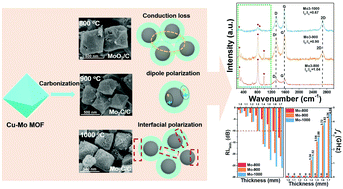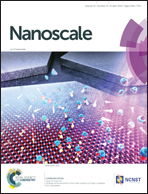Porous-carbon-based Mo2C nanocomposites as excellent microwave absorber: a new exploration†
Abstract
In this study, we report a porous-carbon-based Mo2C nanocomposite (NCs) as the microwave absorber via typical carbothermal reduction using metal–organic frameworks (MOFs) and polyoxometalates (POMs) as the precursors, which have been rarely applied in electromagnetic (EM) wave absorption areas. The elaborately designed NCs not only bring about good impedance matching, but also possess strong dissipation ability due to the large surface areas and porous features. Thanks to the material characteristics as well as structural advantages, the as-prepared Mo2C/C NCs with 20 wt% sample loading exhibit remarkable microwave absorbing performance. The minimum RL value reaches −49.19 dB at matching thickness of 2.6 mm, and the best effective bandwidth (RL < −10 dB) of 4.56 GHz at 1.70 mm was also achieved. Moreover, the NCs overcome the intrinsic drawback of traditional carbon materials, that is, centralized effective absorption always occurred at high frequency (>10 GHz) and the minimum RL value of the NCs shifted to 9.04 GHz. Clearly, in this study, we not only developed the Mo2C NC as the new light absorber, but also paved the way to synthesize other available transition metal carbides using MOFs and POMs.



 Please wait while we load your content...
Please wait while we load your content...